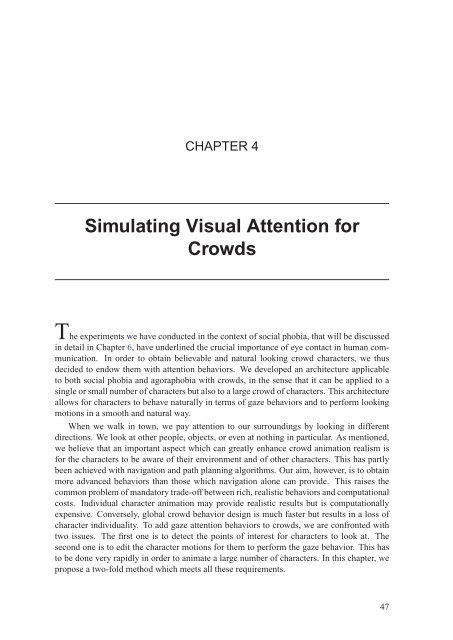Texte intégral / Full text (pdf, 20 MiB) - Infoscience - EPFL
Texte intégral / Full text (pdf, 20 MiB) - Infoscience - EPFL
Texte intégral / Full text (pdf, 20 MiB) - Infoscience - EPFL
Create successful ePaper yourself
Turn your PDF publications into a flip-book with our unique Google optimized e-Paper software.
CHAPTER 4<br />
Simulating Visual Attention for<br />
Crowds<br />
The experiments we have conducted in the con<strong>text</strong> of social phobia, that will be discussed<br />
in detail in Chapter 6, have underlined the crucial importance of eye contact in human communication.<br />
In order to obtain believable and natural looking crowd characters, we thus<br />
decided to endow them with attention behaviors. We developed an architecture applicable<br />
to both social phobia and agoraphobia with crowds, in the sense that it can be applied to a<br />
single or small number of characters but also to a large crowd of characters. This architecture<br />
allows for characters to behave naturally in terms of gaze behaviors and to perform looking<br />
motions in a smooth and natural way.<br />
When we walk in town, we pay attention to our surroundings by looking in different<br />
directions. We look at other people, objects, or even at nothing in particular. As mentioned,<br />
we believe that an important aspect which can greatly enhance crowd animation realism is<br />
for the characters to be aware of their environment and of other characters. This has partly<br />
been achieved with navigation and path planning algorithms. Our aim, however, is to obtain<br />
more advanced behaviors than those which navigation alone can provide. This raises the<br />
common problem of mandatory trade-off between rich, realistic behaviors and computational<br />
costs. Individual character animation may provide realistic results but is computationally<br />
expensive. Conversely, global crowd behavior design is much faster but results in a loss of<br />
character individuality. To add gaze attention behaviors to crowds, we are confronted with<br />
two issues. The first one is to detect the points of interest for characters to look at. The<br />
second one is to edit the character motions for them to perform the gaze behavior. This has<br />
to be done very rapidly in order to animate a large number of characters. In this chapter, we<br />
propose a two-fold method which meets all these requirements.<br />
47

















